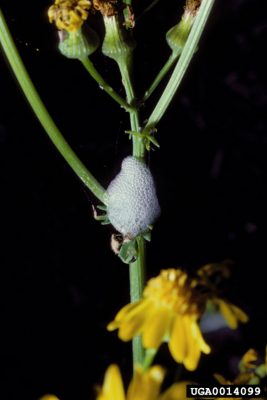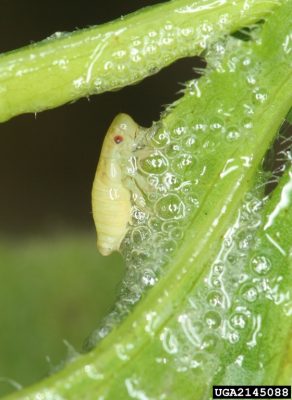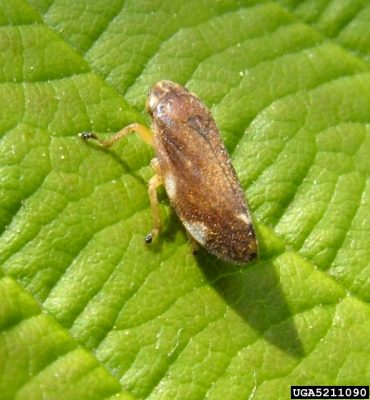Spittlebug: A Unique Little Insect
By Joan Allen

Spittlebugs are common and easily recognized by the white foamy ‘spittle’ produced by the nymph or immature stage of the insects as they feed. Adults are less commonly seen but are commonly known as froghoppers (close relatives of leafhoppers, etc). Depending on the reference, there are anywhere from 30 to 60+ spittlebug species in the United States. All feed on plants, including both woody and herbaceous types. Some spittlebugs have broad host ranges and others narrow.
There is usually only one generation per year and most overwinter in the egg stage inside overwintering plant tissue where they were deposited by the females in from mid to late summer to early fall, depending on species. Hatch occurs in the spring, probably in May in Connecticut. Even though spittlebugs feed by extracting plant sap/juice through needle-like mouth parts, they seldom cause notable injury to the plant. There are a few exceptions including the meadow spittlebug (Philaenus spumarius) and the pine spittlebug (Aphrophora cribata).
The meadow spittlebug has a broad host range that includes both herbaceous and woody plants. It is reported to cause damage in clover, strawberry, mint, herbaceous ornamentals and both coniferous and broad-leaved woody plants when present in high numbers. Other common names include the common froghopper and the cuckoo spit (most common name in the UK). Eggs are laid in the stems or crevices of host plants in the fall. When they hatch in the spring, nymphs usually feed on the plant the eggs were laid on but they will move to younger more tender tissues as the plant grows. There are five nymph stages and all produce spittle as they feed. Once the adult stage is reached, spittle is no longer produced and the adult is quite mobile, quickly jumping a long distance relative to its size when disturbed.
The froghoppers or adult stage are so-called because their bodies are somewhat wider at the rear like a frog. The name

cuckoo spit may have come about because the spittle tends to be first seen in the spring around the same time that the first calls of the cuckoo bird are heard. Most adults are brown to green in color with only subtle markings but some species have striking coloration or patterns. The meadow spittlebug adult is quite variable in coloration.
So, about the spittle. The spittle offers some clear benefits to the nymph(s) hiding within. First, it helps prevent the soft-bodied little guys from drying out. In addition, it protects them from detection by potential parasites and predators. A single mass of spittle may be inhabited by multiple nymphs feeding in the same area on the plant. How is the spittle produced? First, the spittlebug ingests more plant sap than it needs for its nutrition/sustenance. The excess is expelled through the anus as a watery waste product. It mixes with a mucilaginous fluid produced by glands on the abdomen and air bubbles are introduced from a special canal by abdominal contractions. This is pretty interesting stuff going on in gardens, forests and meadows all around us each spring and early summer!
If you would like to get a closer look at a nymph, don’t be afraid to brush the foam carefully away from a plant and look for them inside. They will be up to ¼” long depending on their stage of development and may be yellowish, greenish or brown in color. They are elongated and generally are positioned head down. This facilitates the movement of the spittle downward to cover them. Nymphs are shy and will not be happy to be exposed. They will attempt to walk away but cannot run or fly.

The biggest problem with spittlebugs in the garden, whether it’s an ornamental or food garden, is the unsightliness of the spittle masses. Spittle and nymphs can both be washed off the plants with a steady stream of water. On a small scale, they can be hand-removed and disposed of. Normally, no chemical controls are recommended and the spittle protects nymphs from contact insecticides. Not sure if there are enough spittlebugs to cause plants to be weakened? Look for distorted or stunted new growth, and of course numerous spittle masses on the same plant.